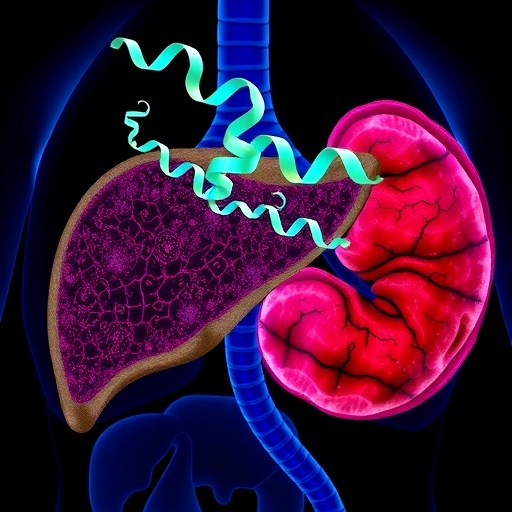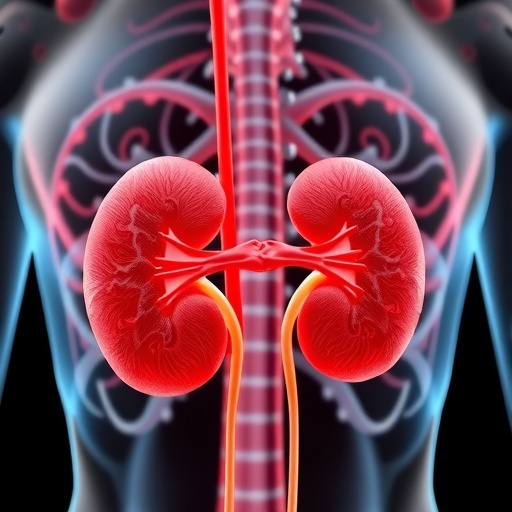
In recent years, metabolic dysfunction-associated steatotic liver disease (MASLD), formerly known as non-alcoholic fatty liver disease (NAFLD), has emerged as a leading cause of chronic liver conditions worldwide. Affecting approximately a quarter of the global population, MASLD manifests as excessive fat accumulation in the liver in the context of metabolic dysfunction, progressing from simple steatosis to potentially cirrhosis and liver failure. Despite its high prevalence, the molecular underpinnings driving MASLD remain incompletely understood, hindering the development of targeted therapies. A groundbreaking study by Ouyang, Su, Li, and colleagues sheds new light on the pathogenesis of MASLD by identifying a critical role for GTPase-activating protein-binding protein 1 (G3BP1), revolutionizing our understanding of this complex disease.
The research highlights the dysregulation of G3BP1 as a pivotal event in the onset and progression of MASLD. G3BP1 is a well-known RNA-binding protein involved in stress granule assembly and regulation of RNA metabolism. Its conventional role primarily centers around cellular stress responses, but this study unveils an unexpected function in metabolic regulation within hepatocytes. The investigators demonstrate that aberrant G3BP1 activity disrupts lipid metabolism, triggering intracellular cascades that culminate in hepatic steatosis and inflammation, hallmarks of MASLD pathology.
Employing state-of-the-art omics technologies and in vivo disease models, the authors meticulously mapped the molecular interactions orchestrated by G3BP1. They utilized transcriptomic profiling to reveal that G3BP1 dysregulation alters the expression of key genes associated with lipid biosynthesis, fatty acid oxidation, and inflammatory signaling pathways. This comprehensive dataset suggests that G3BP1 operates at a critical nexus connecting metabolic homeostasis and immune activation within the liver microenvironment, thereby propelling disease progression.
.adsslot_JnWz8MrxOc{width:728px !important;height:90px !important;}
@media(max-width:1199px){ .adsslot_JnWz8MrxOc{width:468px !important;height:60px !important;}
}
@media(max-width:767px){ .adsslot_JnWz8MrxOc{width:320px !important;height:50px !important;}
}
ADVERTISEMENT
Furthermore, the study explored the mechanistic pathways linking G3BP1 dysfunction to metabolic derangements. It was found that G3BP1 aberrations impair the normal assembly of stress granules, cellular compartments that modulate mRNA stability and translation under stress conditions. This disruption leads to the persistence of specific lipid metabolism-related transcripts in an unstable state, skewing their expression profiles and fostering lipid droplet accumulation inside hepatocytes. The resultant lipotoxicity induces cellular stress and promotes recruitment of inflammatory cells, creating a vicious cycle exacerbating liver injury.
Interestingly, the researchers uncovered that restoring G3BP1 function in preclinical murine models effectively attenuated fatty liver phenotypes and reduced inflammatory markers. This proof-of-concept intervention highlights the therapeutic potential of targeting G3BP1 pathways to reverse or halt MASLD progression. Given the current absence of approved pharmacological treatments for MASLD, this discovery may catalyze a new avenue for drug development aiming at molecular modulators of RNA-binding proteins.
Beyond its direct implications for MASLD, the findings also open intriguing questions about the broader role of stress granule dynamics in metabolic diseases. G3BP1 and its related family members may represent a conserved molecular axis integrating cellular stress responses with metabolic regulation. This paradigm challenges traditional binary views that separate metabolic and inflammatory components, underscoring the intricate interplay within hepatocytes that governs disease onset.
The study’s multidisciplinary approach, combining molecular biology, genetics, RNA sequencing, and sophisticated animal modeling, exemplifies the cutting-edge science propelling personalized medicine. By unraveling the multifactorial causes of liver steatosis, it provides a robust framework for designing targeted interventions tailored to individual molecular signatures. Moreover, it reinforces the importance of RNA-binding proteins as key regulators, potentially illuminating novel biomarkers for early diagnosis and progression monitoring.
Additionally, the research aligns with growing evidence linking metabolic dysfunction in the liver to systemic diseases such as type 2 diabetes and cardiovascular complications. By establishing G3BP1 as a critical modulator, the work hints at the possibility that modulating this protein could produce dual benefits in addressing metabolic syndrome components beyond the liver. Such integrative perspectives are crucial as the medical community confronts the global epidemic of metabolic disorders.
From a translational standpoint, the authors highlight potential strategies to manipulate G3BP1 activity through small molecules or RNA-based therapeutics. Encouragingly, their data suggest that partial modulation, rather than complete inhibition of G3BP1, may suffice to restore metabolic balance, potentially minimizing off-target effects. This precision-targeting concept fits well within emerging therapeutics employing RNA interference and CRISPR-based gene editing, heralding a new class of MASLD treatments.
Despite its groundbreaking nature, the study acknowledges certain limitations warranting future investigation. The long-term effects of G3BP1 modulation on liver function, immune homeostasis, and systemic metabolism remain to be fully elucidated. Additionally, exploring how environmental factors such as diet, gut microbiota, and genetic predispositions influence G3BP1’s regulatory network could yield comprehensive insights needed for holistic MASLD management.
In the broader context of liver research, the identification of G3BP1 as a master regulator redefines our understanding of how intracellular RNA dynamics contribute to metabolic diseases. Historically, research focused primarily on enzymatic control of lipid pathways or inflammatory cytokine signaling; however, this study unmasked a novel regulatory layer mediated by RNA-binding proteins. Such conceptual advancements could inspire parallel investigations in related metabolic organs, such as adipose tissue or pancreas.
The implications extend to clinical practice as well. Incorporating measurements of G3BP1 expression or activity into diagnostic panels might allow stratification of MASLD patients based on molecular phenotypes, guiding tailored interventions and monitoring responses. Early detection strategies centered on RNA-binding protein signatures may improve patient outcomes by enabling timely lifestyle modifications and pharmacological treatments.
Public health experts have long emphasized the critical need for addressing metabolic liver diseases, given their escalating prevalence and association with morbidity and mortality worldwide. This pioneering research provides a tangible molecular target, rekindling hope for effective therapies that can curb the tide of MASLD. Moreover, by connecting cellular stress response mechanisms to metabolic dysfunction, it accentuates the importance of integrated approaches for complex disease treatment.
In conclusion, the study by Ouyang and colleagues pushes the frontiers of hepatology by revealing how GTPase-activating protein-binding protein 1 dysregulation orchestrates the pathogenesis of MASLD. Their findings elucidate fundamental pathways linking RNA metabolism, lipid homeostasis, and inflammation within the liver, thereby unlocking novel therapeutic possibilities. As metabolic diseases continue to surge globally, such scientific advances are indispensable in shaping the future landscape of diagnosis, treatment, and prevention.
Subject of Research: The molecular role of GTPase-activating protein-binding protein 1 (G3BP1) in the pathogenesis of metabolic dysfunction-associated steatotic liver disease (MASLD).
Article Title: Dysregulation of GTPase-activating protein-binding protein1 in the pathogenesis of metabolic dysfunction-associated steatotic liver disease.
Article References:
Ouyang, Q., Su, J., Li, Y. et al. Dysregulation of GTPase-activating protein-binding protein1 in the pathogenesis of metabolic dysfunction-associated steatotic liver disease. Nat Commun 16, 7570 (2025). https://doi.org/10.1038/s41467-025-63022-z
Image Credits: AI Generated
Tags: cellular stress responses in hepatocyteschronic liver conditions worldwidefatty liver disease pathogenesisG3BP1 role in liver healthGTPase-Activating Protein 1 dysregulationhepatic steatosis and inflammationmetabolic dysfunction-associated steatotic liver diseasemetabolic regulation and liver disease.non-alcoholic fatty liver disease insightsomics technologies in liver researchRNA-binding protein and liver metabolismtargeted therapies for MASLD





